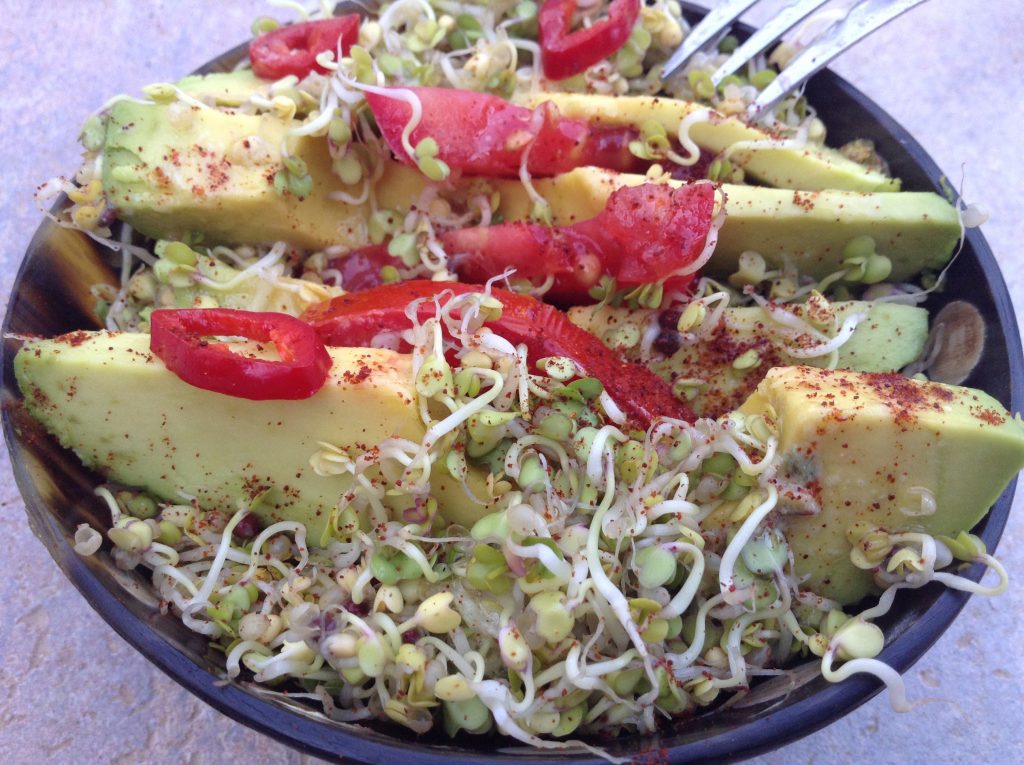Sprouted Wild Mustard Seed Salad
You can grind wild mustard seeds and combine them with water, vinegar, beer, or wine to make your own mustard paste. But what I’m going to share here is how to sprout them. Sprouting is how you turn a scant few spoonfuls of wild seeds into almost two cups of spicy, juicy, crunchy sprouts.
Although wild mustard leaves can be a tasty vegetable raw or cooked, and the flowers are delicious and cute in salads, the seeds often go to waste. That’s even though the seeds are the part of cultivated mustard plants most harvested for commercial purposes (and used to make that jar of prepared mustard in your refrigerator). But those same seeds are often neglected by foragers.

wild mustard plant
I know, because I used to skip what seemed like the overly labor intensive process of gathering and winnowing those tiny seeds. But it turns out to be fairly easy, and I’ve been a convert to the mustard seed harvest for many years now.

wild mustard seeds, unwinnowed
Here’s a video to help you easily harvest and winnow wild mustard seeds.
Next, sprout ’em!
This info and the recipe that follows are from my book The Forager’s Feast: How to Identify, Gather, and Prepare Wild Edibles (yeah, that was a shameless book plug).

sprouted wild mustard seed and avocado salad with chipotle dressing
How to Sprout Wild Mustard Seeds
- Put three tablespoons of wild mustard seeds in the bottom of a wide mouth pint jar (believe it or not, those three tablespoons will morph into almost a full pint of sprouts, so don’t be tempted to add more).
- Fill the jar with water. Cover the top with a piece of cheesecloth, butter muslin, or screen and secure that with a rubber band or string. Let the seeds soak eight to 12 hours or overnight.
- Drain the seeds in a fine mesh sieve and rinse them under cool water. Put them back into the jar still wet from their rinse, but don’t add any additional water at this time. Cover with a breathable material as before, and place somewhere away from direct light or heat.
- Twice a day, rinse the seeds and return them to their jar. Around day two or three, you’ll see the seeds start to germinate. They look a bit like quinoa at that stage. Soon they’ll start looking more like alfalfa sprouts. When they reach the alfalfa sprout stage, move them into a sunnier spot for a day - keep an eye on them to make sure they don’t dry out.
- On day 4 or 5, dump the sprouts into a bowl and cover them with cool water. Untangle them somewhat with your fingers and swish them around to release the seed hulls. These will float to the top where you can skim them off with a spoon. Repeat with a few changes of water. You won’t get 100% of the hulls, but by removing most of them you will greatly improve the mouthfeel of your final product.
- Drain the mustard sprouts well and transfer them to a covered container. Store in the refrigerator and use within five days.
Spicy Sprouted Mustard Seed and Avocado Salad
Serves two
Sprouted mustard seeds and a mustard based dressing make that plant the star of this salad. Creamy avocado balances it. Add the chile peppers if, like me, you like it hot. Leave them out for a milder variation.
Ingredients:
1 pint sprouted mustard seeds
1 medium tomato, sliced
1/2 of a medium sized, ripe avocado, sliced lengthwise
4 tablespoons extra-virgin olive oil
2 tablespoons freshly squeezed lemon juice
1 tablespoon Dijon or homemade prepared mustard
1/2 salt
1/4 teaspoon dried thyme
1/4 teaspoon freshly ground black pepper
1/8 teaspoon liquid smoke OR ground chipotle peppers (optional)
1 small chile pepper, stem end and seeds removed, thinly sliced (optional)
- Divide the sprouts between two bowls and arrange them so that they form little nests. Arrange half of the avocado and tomato slices in the center of each mustard sprout nest. Arrange the chile pepper slices, if using, over the top.
- Whisk together the oil, lemon juice, mustard, salt, thyme, pepper, and liquid smoke or chipotle (if using). Drizzle over the vegetables and serve immediately.
“Fantastic. Informative. Top-notch. Lovely time.” - NYC foraging tour participant
The Forager’s Feast: How to Identify, Gather, and Prepare Wild Edibles is part field guide covering 50 plants, mushrooms, and seaweeds with a widespread distribution, and part cookbook for turning these wild edibles into delectable dishes.
“Leda Meredith is, in my opinion, the Foraging Goddess, and the next best thing to this book would be to share a field expedition with her! I highly recommend The Forager’s Feast to anyone who has a love of the wild foods.” - Amazon review by Susan C.
Northeast Foraging: 120 Wild and Flavorful Edibles from Beach Plums to Wineberries

“A book that wild food gatherers of all skill levels will want to own.” - Sam Thayer

Leave a Reply